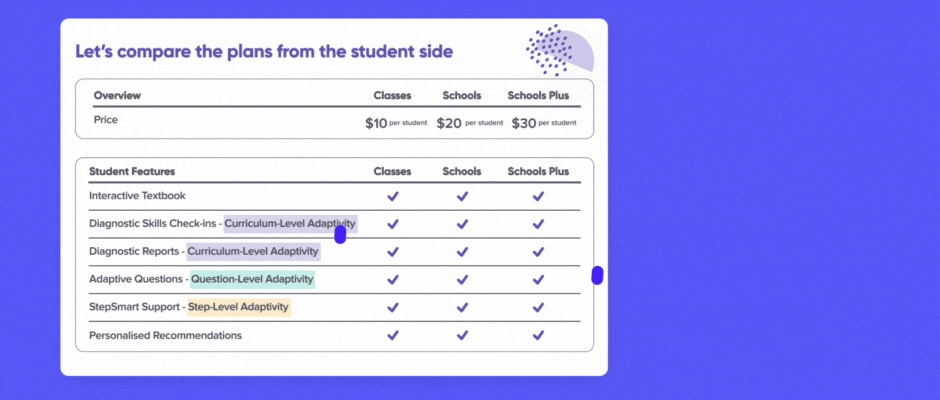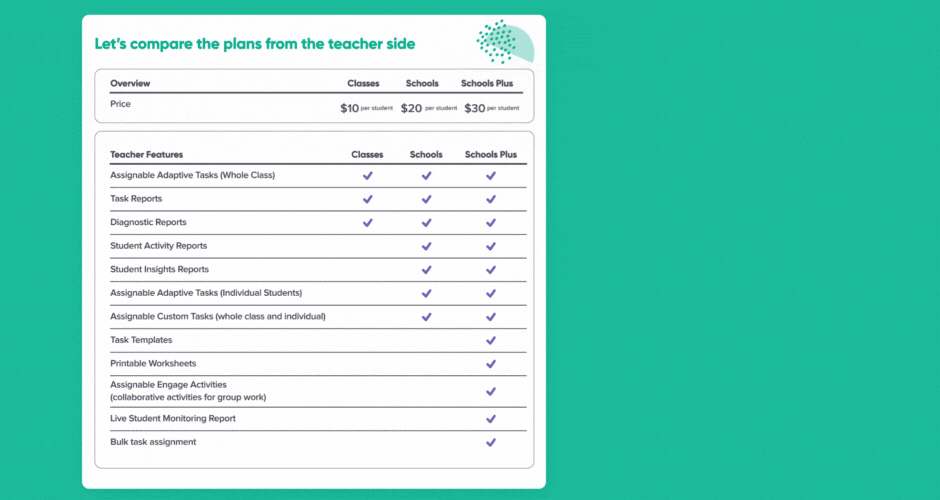“I wonder how much Mathspace costs?”

We’ve been operating as an EdTech company for more than 12 years now. It’s really exciting to see the industry grow and to watch the way today’s mathematics classrooms are using technology in innovative ways to further student learning. But over the course of the 12 years we’ve also experienced the challenges of pricing. There are two big challenges when it comes to EdTech pricing.
The first challenge: Access
The funding disparity within the education system is huge. In turn, this means that schools have radically different budgets. Even within a school, resourcing budgets will often compete with other budgets. This leads to access inequality. Some schools can afford devices, while others can’t. Some schools can afford the latest education technology, while others can’t.
As the founder of an education company with the mission 'to be the right help at the right time for every student,' I often ask myself: who’s ‘job’ it is to fix this?
Over the years we’ve tried a number of initiatives to discount Mathspace for schools with limited budgets. We’ve explored introductory offers, needs-based discounts and corporate sponsorships, to name a few.
But is that fair?
Should a school with more funding pay more, simply because they can? Should Mathspace discount our product, and reduce our earnings, because a school is struggling with limited Government funding? Should we be wearing that cost?
Of course Mathspace also has costs, the bulk of which is dedicated to our staff, who drive our innovation. Should I reduce the size of our workforce, and by extension our level of innovation, so that we can accommodate schools with insufficient funding for what’s fast becoming a core resource?
How to balance our 'desire for equitable access' with 'price fairness' has been a question that has kept me up at night over the years. The reality of the situation is that often the students who could most benefit from Mathspace go to the schools who are least equipped to make use of it.
The second challenge: Transparency
“Book a demo, talk to sales”
This is the kind of language you will see on every EdTech company website. For the last decade these words have also been on our website. And teachers hate it!
I have never met a teacher who likes negotiating on price. Nor have I met many teachers who enjoy the sales process. For most, it’s a necessary evil.
Teachers want to explore resources, but it’s not fair to burden their already packed workloads with a lengthy, tiresome, time consuming and often frustrating sales process.
I’m not saying that EdTech is to blame here. Most of these companies are mission-driven and want to work with schools to meet varying budgets. But this can make price transparency really murky. As EdTech companies try to accommodate budgets, you can end up with schools paying radically different amounts for the exact same product offering.
Our solution: Segment our offering for teachers to accommodate different budgets and use cases, without penalising students
Over the past three years we have made huge inroads into standardising our pricing. We’ve had to increase pricing for early adopters on legacy packages, but schools were generally happy with this as they saw how quickly the product had improved over the years. For schools who simply did not have the budget we’ve used levers like term length discounts to work with them to adjust the price over the length of their contracts.
But we wanted to go to the next level and get to a point where we can be transparent with our pricing while maintaining our commitment to equity. Our goal is to never have a teacher have to think about negotiating a best price, nor decide they can’t use Mathspace because it’s outside of their budget.
So we decided to introduce products tiers. This was a significant product decision, because to do tiering properly, you need to really think about how the product is built. You also need to think about which product features should be available at each tier, without ever losing the real value of Mathspace. Without getting too technical, it essentially meant that we needed to tear things down and rebuild the foundations of Mathspace.
As a bonus we took the opportunity to really simplify the product for new users at the entry level tier so students and teachers could get started completely on their own without ever talking to our sales team. We know how busy you are!
Step 1: Choosing the tiers
When coming up with the pricing tiers we wanted to:
- Provide a low friction way for teachers and students to try the core product features without having to commit to a sales call
- Remove the pressure of a time-limited trial that could provide a barrier to teacher innovation
- Ensure students at under-resourced schools were not disadvantaged compared to students at well resourced schools (as much as we can)
- Have an entry point for teachers to use the product at a price point of no more than $10/student (a level we saw that the vast majority of schools could budget for)
- Ensure the higher tiers provided features that indicate a deeper implementation of Mathspace so that schools who are deriving more value from the product pay in line with that value added
The end result is three versions of Mathspace available at different price points.

Step 2: Choosing which features to put in each tier?
The first and most important decision to make was which student features we provide in each tier. Over the last 12 years we have invested much of our R&D efforts into making Mathspace adaptive at 3 layers; the curriculum layer, the question layer and the step layer. The natural tiering would have been to limit the level of adaptivity at the lower tiers but, looking to our goals for equitable access we decided that we should avoid any tiering on the student side features.
As a result all students will get access to personalised learning at its fullest, regardless of their school funding situation.

So, that left us with the teacher side features to try and align the features with the depth of implementation. The good news here is that the deeper the implementation, the more they can replace other resources (such as textbooks, worksheets, assessment products) and so the more budget they have available.
At a high-level the packages aim to match teacher features with the level of implementation teachers are ready for.
Classes Package: Digital Textbook for assigning grade level work and getting an overview of student performance
Schools Package: Customise for class and individual needs with Advanced Insights reports
Schools Plus Package: Replace your textbook by collaborating with teachers across your school to build your scope and sequence into Mathspace.

What is the result?
So where are we at on the question of how much responsibility we have as an mission-driven company to work towards equal access? Have we got the balance right between equitable access and fairness?
I’m pretty happy with the balance we’ve found. By not segmenting on student features, committing to transparency on pricing and lowering the barrier for efficacy research for teachers, I hope to improve both student access and student learning outcomes while fostering an environment where our staff and our teachers can continue to innovate in the classroom.
I‘m also conscious and more comfortable with the limit of our influence on equitable access to learning resources. In writing this article I hope I’ve helped shine a spotlight on the problems of equity so they can be addressed upstream. If you’re interested in lending your voice to this I recommend you follow the work of Pasi Sahlberg who writes very well about the upstream issues that can help reduce equity at it’s source.
Going one step further: A free self-serve option to help teachers get started
I mentioned above that we took the opportunity to really simplify the 'entry level' version of Mathspace so that students and teachers could get started without any training. We decided to take it a step further and carve out a free version of Mathspace that any teacher or student could pick up and start using without needing to speak to anyone from our team.
While free trials are commonplace for EdTech products, they also present a problem. A free trial forces a teacher into the difficult position of balancing new learning resources and new processes, all within a short space of time and in a high stakes setting. At the end of the experiment, if the school decides to go in another direction, the teacher has lost a lot of time and energy trialling the product.
So instead of limiting our free offering by time, we decided to give teachers free access to one class of up to 30 students to use forever. In doing so we remove the two biggest hurdles for teachers to try new innovations - allowing time and support for implementation and reduced anxiety about potential time wasted investing in the implementation. That’s time they can invest improving their craft for their students instead. You can get started on your own here.
Another benefit of this approach is we have used it to foster a community of teachers focused on the efficacy of the tools that they use. We are so confident that Mathspace will be a more impactful use of student time than any other tool so we want to give teachers the opportunity to try it alongside their existing school’s resources so they can see it for themselves. It forces us to continue to focus efforts on making Mathspace effective for student learning over say a shiny marketing campaign.
Final Note: None of this self-starting talk is meant to take away from our passionate EdTech sales consultants. They are predominantly former educators themselves who would love to hear from you if you prefer to contact our team. We just wanted to make it your choice when you do.

